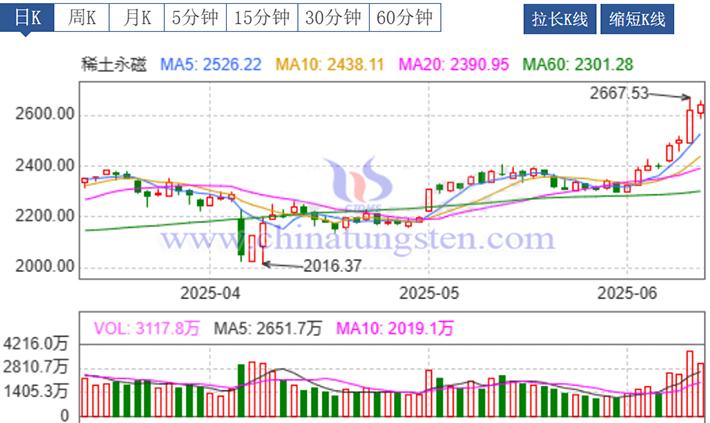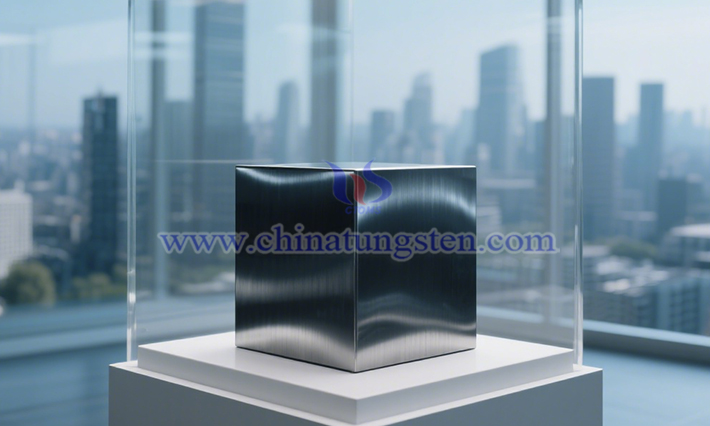The Rare Earth Permanent Magnet Sector Performed Strongly
- Details
- Category: Rare Earth News
- Published on Tuesday, 17 June 2025 11:38
The first U.S.-China economic and trade consultation mechanism meeting was held in London on June 9-10, 2025. Reports indicate that both sides reached a framework agreement in principle to implement the consensus from the June 5 leaders’ call and the Geneva talks. The U.S. Commerce Secretary stated that the trade framework and implementation plan with China should resolve restrictions on rare earths and magnetic materials.
In the context of the meeting’s focus on rare earths and technology exports, the rare earth permanent magnet sector performed strongly. The rare earth magnet index (BK0578) rose from a closing price of 2,398.44 on June 6 to 2,637.63 on June 12, a 9.97% increase over four trading days, decisively breaking the 2,600-point mark. Leading stocks like Beikuang Technology, Zhongke Magnetic Industry, Dadi Bear, and Ningbo Yunsheng surged, with concept stocks such as Zhongke Sanhuan and Hengdian East Magnet also rising.

Rare earth elements (REEs) are a group of 17 metals, including the lanthanide series (lanthanum, cerium, praseodymium, neodymium, promethium, samarium, europium, gadolinium, terbium, dysprosium, holmium, erbium, thulium, ytterbium, lutetium) and scandium and yttrium, which share similar properties. Known for their unique physicochemical characteristics, REEs can absorb and emit light at specific wavelengths, making them widely used in fluorescent materials and laser equipment. Their strong magnetic properties in permanent magnets, such as neodymium-iron-boron, are critical for electric vehicle motors, while rare earth oxides serve as efficient catalysts. REEs are deeply integrated into high-tech industries, green energy, medical applications, and aerospace.
Rare earth permanent magnet materials stand out for their high magnetic energy product and strong coercivity, generating powerful magnetic fields in small volumes with excellent demagnetization resistance, enabling stable operation in high-temperature and complex environments. Doping with elements like dysprosium or terbium allows for tailored magnetic and thermal properties. These materials are vital across multiple sectors: in new energy vehicles, neodymium-iron-boron magnets enable high power density and lightweight drive motors, boosting range; in wind power, permanent magnet direct-drive generators enhance efficiency; in consumer electronics, their thin, low-noise properties support miniaturization in phone vibration motors and wireless earbuds; in medical fields, MRI magnets rely on their high-strength, stable magnetic fields; and in aerospace, samarium-cobalt magnets, with their heat and radiation resistance, are key for missile guidance and satellite attitude control systems.

China leads globally in both rare earth reserves and production, mastering core separation technologies, with 92% of the world’s refined rare earths originating from the country. As of late 2024, China’s reserves stood at 44 million tons, or 48.89% of the global total, with production at 270,000 tons, or 69.23% of the world’s output. Following the U.S. announcement of reciprocal tariffs on China on April 2, 2025, China imposed export controls on seven medium and heavy rare earth items—samarium, gadolinium, terbium, dysprosium, lutetium, scandium, and yttrium—effective April 4. This has impacted high-end manufacturing in some countries, including the U.S.
On June 1, Lianhe Zaobao reported that U.S. auto industry groups warned of potential factory closures within weeks due to an impending shortage of rare earth magnets from China. On June 4, the U.S. Motor & Equipment Manufacturers Association highlighted “serious real-time risks” to parts suppliers’ supply chains, urging immediate action to prevent widespread production disruptions and economic losses.
Given the dual-use military and civilian nature of rare earth items, China’s export controls align with international norms. As a responsible major power, China considers the reasonable needs and concerns of other countries in civilian applications, conducting legal and regulatory reviews of export license applications. A number of compliant applications have been approved, with plans to continue strengthening the approval process.
- Chinatungsten Online: www.chinatungsten.com
- CTIA GROUP LTD: en.ctia.group
- Tungsten News & Price: www.ctia.com.cn
- Molybdenum News & Price: news.molybdenum.com.cn
- Tel.: 86 592 5129696; Email: sales@chinatungsten.com



 sales@chinatungsten.com
sales@chinatungsten.com